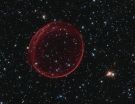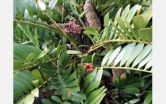(Press-News.org) The delicate shell, photographed by the NASA/ESA Hubble Space Telescope, appears to float serenely in the depths of space, but this apparent calm hides an inner turmoil. The gaseous envelope formed as the expanding blast wave and ejected material from a supernova tore through the nearby interstellar medium. Called SNR B0509-67.5 (or SNR 0509 for short), the bubble is the visible remnant of a powerful stellar explosion in the Large Magellanic Cloud (LMC), a small galaxy about 160 000 light-years from Earth.
Ripples seen in the shell's surface may be caused either by subtle variations in the density of the ambient interstellar gas, or possibly be driven from the interior by fragments from the initial explosion. The bubble-shaped shroud of gas is 23 light-years across and is expanding at more than 18 million km/h.
Astronomers have concluded that the explosion was an example of an especially energetic and bright variety of supernova. Known as Type Ia, such supernova events are thought to result when a white dwarf star in a binary system robs its partner of material, taking on more mass than it is able to handle, so that it eventually explodes.
Hubble's Advanced Camera for Surveys observed the supernova remnant on 28 October 2006 with a filter that isolates light from the glowing hydrogen seen in the expanding shell. These observations were then combined with visible-light images of the surrounding star field that were imaged with Hubble's Wide Field Camera 3 on 4 November 2010.
With an age of about 400 years, the supernova might have been visible to southern hemisphere observers around the year 1600, although there are no known records of a "new star" in the direction of the LMC near that time. A much more recent supernova in the LMC, SN 1987A, did catch the eye of Earth viewers and continues to be studied with ground- and space-based telescopes, including Hubble.
INFORMATION:
Notes
The Hubble Space Telescope is a project of international cooperation between ESA and NASA.
Image credit: NASA, ESA, and the Hubble Heritage Team (STScI/AURA). Acknowledgement: J. Hughes (Rutgers University)
Links
Images of Hubble: http://www.spacetelescope.org/images/archive/category/spacecraft/
NASA HubbleSite release: http://hubblesite.org/newscenter/archive/releases/2010/27/
Contacts
Oli Usher
Hubble/ESA
Garching, Germany
Tel: +49-89-3200-6855
Email: ousher@eso.org
Ray Villard
Space Telescope Science Institute
Baltimore, USA
Tel: +1-410-338-4514
Email: villard@stsci.edu
Keith Noll
Space Telescope Science Institute
Baltimore, USA
Tel: +1-410-338-1828
Email: noll@stsci.edu
Hubble spots a celestial bauble
2010-12-15
ELSE PRESS RELEASES FROM THIS DATE:
What 'pine' cones reveal about the evolution of flowers
2010-12-15
From southern Africa's pineapple lily to Western Australia's swamp bottlebrush, flowering plants are everywhere. Also called angiosperms, they make up 90 percent of all land-based, plant life.
New research published this week in the Proceedings of the National Academy of Sciences provides new insights into their genetic origin, an evolutionary innovation that quickly gave rise to many diverse flowering plants more than 130 million years ago. Moreover, a flower with genetic programming similar to a water lily may have started it all.
"Water lilies and avocado flowers ...
Unique case study on Alzheimer's disease
2010-12-15
A case study from the Swedish medical university Karolinska Institutet sheds light on the pathological course of Alzheimer's disease. The brain of the first Alzheimer's patient to display amyloids demonstrable with a PET scanner has been studied, both during progression of the disease and after death.
One pathological characteristic of Alzheimer's disease is the accumulation in the brain of beta-amyloid proteins to form amyloid plaques. However, it is not known how early the plaques forms in the brain, whether they are the primary cause of the disease or what pathogenic ...
Violent games not to blame for youth aggression
2010-12-15
How depressed young people are strongly predicts how aggressive and violent they may be or may become. Contrary to popular belief, however, exposure to violence in video games or on television is not related to serious acts of youth aggression or violence among Hispanics in the US, according to new research by Dr. Christopher Ferguson from Texas A&M International University. His findings are published online in Springer's Journal of Youth and Adolescence.
The potential negative effects of violent video games on adolescent antisocial behavior, and youth violence in particular, ...
Drug use and discrimination among Phoenix area Mexican heritage youth
2010-12-15
Washington, DC, December 14, 2010—Perceived ethnic discrimination among Mexican and Mexican American students from Phoenix-area middle schools places them at risk for increased stress when trying to acculturate with mainstream U.S. culture, according to a new study. As the students experienced acculturation stress related to discrimination, they were at a higher risk for alcohol, cigarettes, and marijuana use. The study is in the December issue of Prevention Science, a peer-reviewed journal of the Society for Prevention Research.
"As levels of perceived discrimination ...
Research leads to fewer yellowjackets on Christmas trees
2010-12-15
Hawaiians can now worry less about finding stray yellowjackets living in their Christmas trees shipped from the mainland United States, partly due to research by a U.S. Department of Agriculture (USDA) scientist and his university and state cooperators.
Every year, fir trees from the Pacific Northwest are shipped to Hawaii for use as Christmas trees. Although yellowjackets usually nest in the ground, mated queens who haven't yet built their nests sometimes make fir trees their home during winter. So, when the trees are harvested in November for shipment to Hawaii, the ...
UNH-led experiment hurtled into aurora above Norway by NASA rocket
2010-12-15
DURHAM, N.H. –- A team of scientists led by Marc Lessard of the University of New Hampshire Space Science Center launched an instrument-laden, four-stage sounding rocket from Norway's Andøya Rocket Range into aurora about 200 miles above Earth early Sunday morning (Dec. 12, 2010), just before the two-week launch window slammed shut. For the 10-minute flight, a 65-foot-long Black Brant XII rocket arced through a funnel-shaped region of Earth's magnetic field lines before landing some 900 miles downrange in the Norwegian Sea. The science data were transmitted to a ground ...
Inhaled corticosteroids increase diabetes mellitus risk
2010-12-15
New York, NY, December 14, 2010 – Inhaled corticosteroids are widely used in the treatment of asthma and chronic obstructive pulmonary disease (COPD). However, these drugs may be associated with diabetes development and progression. In a study published in the most recent issue of The American Journal of Medicine, researchers found that inhaled corticosteroids were associated with a 34% increase in the rate of diabetes onset and in the rate of diabetes progression. At the highest inhaled doses the risk increased by 64% in diabetes onset and 54% in diabetes progression.
Although ...
Go ahead, drink your milk
2010-12-15
If you're unsure about what foods to eat to maintain a healthy diet, you're not alone. Increasing evidence continues to point people back to basics – and reach for the milk. A study to be published in the January edition of American Journal of Clinical Nutrition reveals that drinking three glasses of milk per day may lead to an 18% decreased risk of cardiovascular disease.
The research conducted at Wageningen and Harvard Universities, examined 17 studies from Europe, USA and Japan, also found no link between the consumption of regular or low-fat dairy and any increased ...
Fast food and sweets advertised when children watch television
2010-12-15
Children in Sweden are exposed to a huge number of TV advertisements. Food adverts – primarily for fast food and sweets – dominate the advertisements shown during children's viewing times. Research from the University of Gothenburg, Sweden, shows that Sweden is no different from other countries when it comes to the number of adverts that children are exposed to.
Children between the age of three and 12 in Sweden encounter an average of 50 or so TV advertisements for food a week, dominated (in descending order) by fast food, alcohol, chocolate and sweets. The results were ...
Swedes happier than before
2010-12-15
Swedes are both happy and content with their lives, reveals a report from the SOM Institute at the University of Gothenburg, Sweden. The factors that contribute most to a sense of wellbeing are good health, family and friends, a good home and personal finances. Clothes and appearance play only a very minor role.
More and more Swedes are describing themselves as happy and content. When the SOM Institute asked: "On balance, how content are you with the life you live?" and "On balance, how happy would you say you are?", nine out of ten replied that they are both content ...


